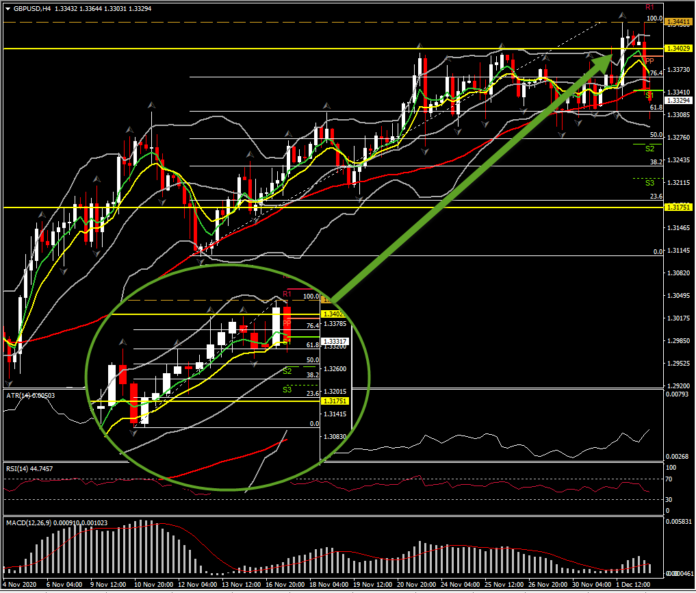The Pound has declined against most currencies, having more than given back short-lived gains that were seen on news that the UK government has approved the Pfizer-BioNTech Covid vaccine. Cable posted a high at 1.3441, which matched yesterday’s 3-month peak, before dropping back to the mid1.3300s. Technically, this looks to be ready to form a tweezer top however this needs further confirmation in the near term, with a daily close of the immediate support at the 1.3300 (round number and 61.8% Fib. level).
Selling into gains seems the prudent tactical move given:
- Market participants being well aware that the UK had set itself up to be first in line for vaccinations, having pre-ordered substantial quantities of all three leading vaccines, including the Moderna and AstraZeneca versions
- The lack of a breakthrough in down-to-the-wire EU-UK trade negotiations. Many market participants are in a state of non-commitment, waiting on concrete developments from the ongoing negotiations between the EU and the UK.
Yesterday had last week been touted as the deadline for the EU-UK talks, but now the latest deadline is reportedly this Saturday, while there have been reports that the European parliament could convene as late as December 28 to ratify a trade deal. Germany’s Merkel has been putting the pressure on EU states to compromise.
Pressure on the UK government is intense. Brexit ideologues in PM Johnson’s party are demanding that no quarter is given to the EU, while a leaked Whitehall document this week warned of a “perfect storm” of chaos in the event of a no-deal in the Covid-19 era. US president elect Biden warned London that the scope for a deal with the US would be compromised if there is a return of a hard border on Ireland — which is what could happen in a no deal.
In the no-deal scenario, the UK government would have the choice between respecting the withdrawal agreement it signed with the EU to maintain a free-flowing border on Ireland, at the price of imposing a border down the Irish Sea between Northern Ireland and the rest of the UK, a scenario that would likely spark protests and quite possibly violence from loyalist militants, or break the EU withdrawal agreement, which would result in a hard Irish land border and a lot of bad faith between the UK and EU and the UK and the US, and quite possibly violence from republican militants. The stakes are high, which is why a deal is widely expected.
Despite the negotiations dragging on, market participants are so far refraining from pricing in a no-deal outcome, as evidenced by the stability of the Pound. Some political pundits have been arguing that there is a risk that the only way forward may be a no-deal — which in the event would in effect mean that a deal is delayed, at the price of near-term logistical chaos and with what the OECD warned yesterday would be a “serious” economic hit. On Friday, the BBC cited an unnamed source saying face-to-face talks will take place in London over the weekend, though the EU’s Barnier would not travel unless the UK changed its negotiating stance. Fishing and level playing field rules remain the major blocks.
What is clear, deal or no deal, is that the EU and UK’s relationship will be an ever evolving and complicated one when the UK exits its transition membership of the common market and customs union at year end. The UK wants to diverge from EU rules, while EU states are concerned that the UK will undercut their markets. The relationship will be subject to dispute arbitration with the possibility of retributive measures. This is why markets are anticipating only a narrow free trade deal, which would be centred on manufacturing.
Note that the EU is considering a stopgap measure for UK financial services to kick in on January 1. The European Commission reportedly told member states this week that a decision on equivalence won’t be ready until next year (the UK financial markets must maintain equivalent rules to access EU markets).
Click here to access the Economic Calendar
Andria Pichidi
Market Analyst
Disclaimer: This material is provided as a general marketing communication for information purposes only and does not constitute an independent investment research. Nothing in this communication contains, or should be considered as containing, an investment advice or an investment recommendation or a solicitation for the purpose of buying or selling of any financial instrument. All information provided is gathered from reputable sources and any information containing an indication of past performance is not a guarantee or reliable indicator of future performance. Users acknowledge that any investment in Leveraged Products is characterized by a certain degree of uncertainty and that any investment of this nature involves a high level of risk for which the users are solely responsible and liable. We assume no liability for any loss arising from any investment made based on the information provided in this communication. This communication must not be reproduced or further distributed without our prior written permission.



















